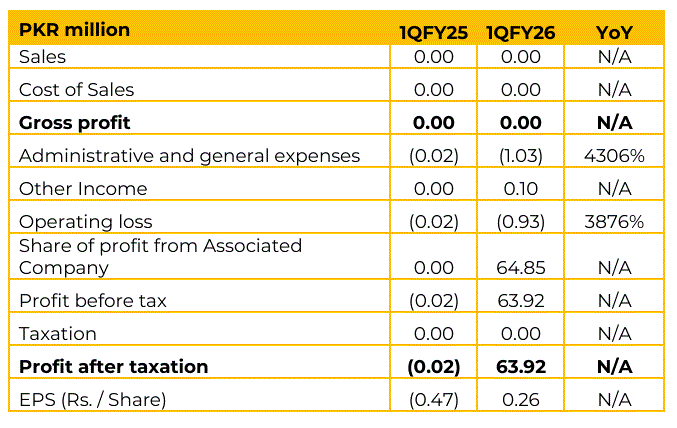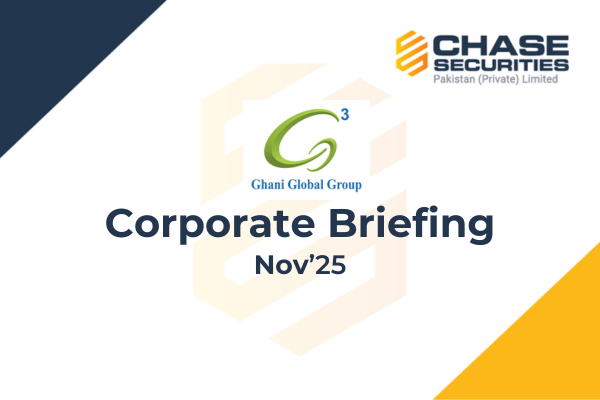GWCL reported earnings per share of PKR 0.26 in 1QFY26, as compared to loss per share of PKR 0.47 in SPLY. Profitability in the quarter was mainly contributed by the share of profit from associates of PKR 64 million in 1QFY26. The production is expected to commence from first week of December 2025.
GCWL’s project is the first large-scale import substitute manufacturing project in Pakistan of its kind, intended to reduce reliance on imports and produce Calcium Carbide locally for both domestic requirements and export. The plant is located in the Hattar Special Economic Zone (SEZ). The project is eligible for a 10-year income tax exemption.
This income tax exemption applies to both local manufacturing/sales and exports due to the SEZ status. Plant’s annual capacity is roughtly 25,000 tons per annum. Calcium Carbide (CaC₂) is the main product used primarily for the manufacturing of Acetylene gas, which is widely utilized for precise cutting and welding applications. It also serves as a basic chemical in various other industries.
Precipitated Calcium Carbonate (PCC) is another product used widely in industries such as a filler and coating pigment in the paper industry, as a stabilizer for plastic and rubber, for glossiness and whiteness in paints and coatings, and as a supplement/stabilizer in the food and pharma industries. Lime or Calcium Oxide (CaO) is primarily used in leather tanning, sugar refining, and the paper and pulp industry (alkaline process).
Demand is driven by construction, agriculture, water treatment, and environmental applications. The primary raw materials for Calcium Carbide are Limestone and Coke. Limestone is sourced locally. The cost is approximately PKR 3,000 per ton (including transportation to the plant). GCWL buys limestone from mine owners and does not mine it itself, thus incurring no royalty charges. Coke/Semi-Coke is imported, primarily from China. The price range for the specified quality is $325 to $350 per ton. Management avoids cheaper Iranian coke due to its high sulfur content, prioritizing quality.
The plant uses an Electric Arc Furnace; electricity is the primary fuel source, and coal is not used for gasification. Total electrical requirement is roughly 11 to 12 MW. The company hopes to benefit from any applicable three-year subsidized electricity package for industry.
Management noted that the domestic market size for CaC2 is roughly 12,000 to 15,000 tons per annum. Current Market is highly import-dependent, with over 95% of local requirement served through imports (primarily from China). The current market is fragmented among many small distributors.
Ghani group is already engaged in trading the product for 15 years and currently handles about 40% of the local market through imports. GCWL targets capturing around 90% of the local market with local production. Targeting markets in the Middle East (due to a lack of local production there), Central Asia, Eastern Europe, and Turkey. Qualification processes with key users are underway, and exports are expected to begin within a few weeks after commercial production. GCWL expects to be highly competitive due to cost benefits from local production.
Management plans to petition the Government of Pakistan to review the duty structure and potentially raise the current 7-8% duty back up to 16% (which falls within the category) to support the local industry and discourage reliance on foreign exchange for imports. Expected production for the first fiscal year (7 months from December onwards) is 10,000 to 11,000 tons. Management hopes to achieve 80% capacity utilization in the second full year. Revenue for the first year (7 months) is expected to be PKR 3 to 4 billion.
While, the next year is expected to yield PKR 8 to 9 billion in revenue. Net profit margin for the first year (7 months) is expected to be around 6-7%. While from the next year it could go up to 10%, excluding the share of profit from associate. Going forward, if the primary products (Calcium Carbide and PCC) are unable to fully load the plant (80% utilization), they will initiate the Phase II (secondary products). The process allows for the potential manufacture of Carbon Black, Acetylene Gas, Hydrogen Gas, and Magnesium Oxide as derivates (secondary products). These derivatives are considered profitable and can utilize the finer, smaller-sized (2-6 mm) crushed Calcium Carbide to product Carbon Black (di-electric carbon).
Additional capex for Hydrogen and Carbon Black could be roughtly around PKR 1.2 billion. The capex required for magnesium oxide is estimated at PKR 500 million. Management may defer or sacrifice this product if the demand for their current Lime product is very high.

Important Disclosures
Disclaimer: This report has been prepared by Chase Securities Pakistan (Private) Limited and is provided for information purposes only. Under no circumstances, this is to be used or considered as an offer to sell or solicitation or any offer to buy. While reasonable care has been taken to ensure that the information contained in this report is not untrue or misleading at the time of its publication, Chase Securities makes no representation as to its accuracy or completeness and it should not be relied upon as such. From time to time, Chase Securities and/or any of its officers or directors may, as permitted by applicable laws, have a position, or otherwise be interested in any transaction, in any securities directly or indirectly subject of this report Chase Securities as a firm may have business relationships, including investment banking relationships with the companies referred to in this report This report is provided only for the information of professional advisers who are expected to make their own investment decisions without undue reliance on this report and Chase Securities accepts no responsibility whatsoever for any direct or indirect consequential loss arising from any use of this report or its contents At the same time, it should be noted that investments in capital markets are also subject to market risks This report may not be reproduced, distributed or published by any recipient for any purpose.

